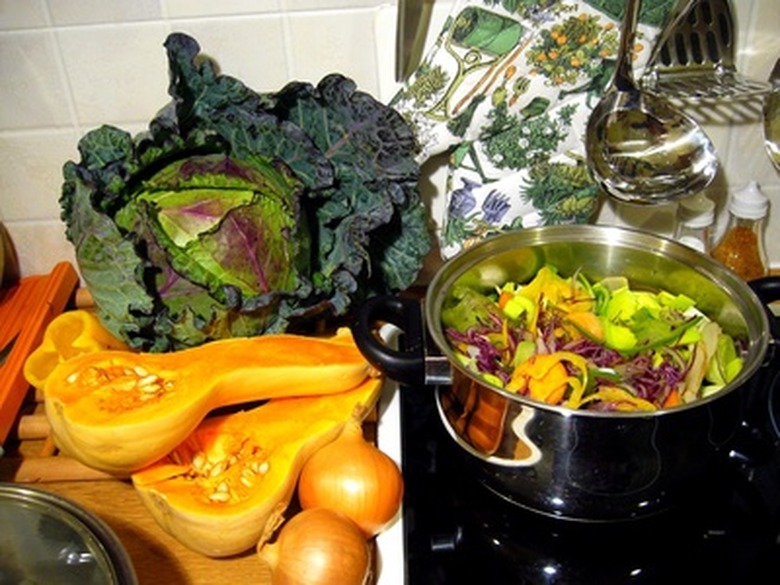What Vegetables Grow In Washington, DC
Hot, humid summers and somewhat mild winters typify the extremes of seasonal weather in Washington, D.C., and the city's long growing season makes it good for growing hot-weather vegetables like tomatoes, peppers and squash. Cool spring-weather plants include peas, lettuce and radishes. Long, mild autumns give Washington, D.C., an advantage for growing late-season crops such as broccoli, kale and cabbage, as well as root crops like potatoes, garlic and onions.
Peas
Because winters in the Washington, D.C., region tend to be mild, peas should be planted as early as possible, or as soon as the ground can be worked. This is usually by mid-March, but if a particularly cold winter is forecast, gardeners can plant peas in late December. Peas will germinate and sprout in the spring if planted in late winter. If you've never planted legumes in your garden before, you will need to inoculate peas with a special bacterial powder, available at most garden centers and hardware stores.
- Hot, humid summers and somewhat mild winters typify the extremes of seasonal weather in Washington, D.C., and the city's long growing season makes it good for growing hot-weather vegetables like tomatoes, peppers and squash.
- Because winters in the Washington, D.C., region tend to be mild, peas should be planted as early as possible, or as soon as the ground can be worked.
Lettuce
Most varieties of this tender favorite perform well under cooler weather conditions, though some Romaine varieties perform well under moderate heat. Plant seeds as soon as the soil becomes workable, and consider planting taller vegetables nearby in late spring to provide some shade for lettuces as the weather grows warmer. Most lettuce varieties will bolt, or go to seed, when temperatures are consistently above 80 degrees, but the long cool autumn months make for an ideal second growing season.
Chard
If you've been looking for a vegetable that grows well under nearly any condition and that is nutritious and beautiful to boot, then chard is the plant for you. This leafy green is a candidate for cut-and-come-again culture: snip the outer leaves to use raw in salads or cooked like spinach, and leave the inner leaves to regenerate. Chard grows best in cooler weather but continues to produce throughout the summer if it gets a bit of shade. "Bright Lights" produces plants with neon yellow, red and green stems; "Fordhook Giant" is a white-stemmed variety most often seen in stores.
- Most varieties of this tender favorite perform well under cooler weather conditions, though some Romaine varieties perform well under moderate heat.
- Most lettuce varieties will bolt, or go to seed, when temperatures are consistently above 80 degrees, but the long cool autumn months make for an ideal second growing season.
Tomatoes
Because spring temperatures can be unpredictable, tomatoes perform best when planted as starts, or young plants about a foot tall. Tomato flowers will not pollinate when temperatures are much over 90 degrees, so fruiting will stall out during the hottest part of the summer, usually in late July and early August. However, plants will continue to set and ripen new fruit until well into September and October, when overnight temperatures begin to dip low enough to discourage growth.
Peppers
Like tomatoes, the best-performing peppers should be planted as starts and situated in a spot with generous sunlight throughout the day. Peppers like heat, but keep them watered during dry spells to encourage fruit growth. Sweet peppers as well as hot favorites like jalapeno and habanero all grow well in Washington, D.C.
Squash
Don't attempt to set squash out too early. The Washington region is prone to surprise late-spring frosts that will kill all but the hardiest early vegetables. Squash plants like pumpkins, yellow squash, zucchini and winter squashes all need daytime temperatures of 80 degrees and above for vigorous growth and will not withstand cold nights. Avoid watering plants in the evening, as this promotes growth of powdery mildew. Squash vine borers are also a problem. Check the undersides of leaves for eggs during the breeding months of late May to early July.
- Because spring temperatures can be unpredictable, tomatoes perform best when planted as starts, or young plants about a foot tall.
- Tomato flowers will not pollinate when temperatures are much over 90 degrees, so fruiting will stall out during the hottest part of the summer, usually in late July and early August.
Okra
If for no other reason than to inspire curiosity in your neighbors, plant okra. The distinctive star-shaped leaves and finger-length pods make this vegetable a conversation starter, but okra loves the heat and thrives in the hot, humid Washington summers. Plants do best in full sun and planted in well-drained soil. While the plant can tolerate some amount of drought, water deeply every few days during hot, dry spells.
